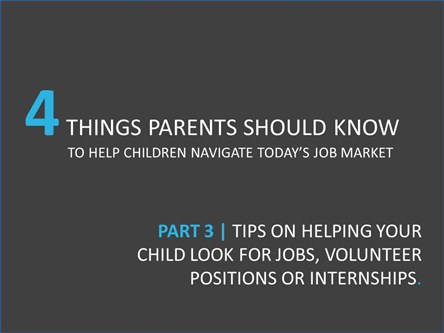4 Things Parents Should Know to Help Children Navigate Today’s Job Market – Part 3

- Part III: Tips on how to help your child begin the process of looking for volunteer positions, internships or paid work.
We are at the point in this series where it comes down to action.
In this section it is time to help your child create her brand: who she is. There are two ways that she will present who she is to a prospective employer: her resume and the stories she will share.
With higher youth unemployment and many youth underemployed, the competition is greater today than ever before. This means that your child’s resume needs to stand out from the crowd.
A resume is an extension of who she is. It is not just a piece of paper that highlights her past experiences. Rather, it shares the impact that she has made in previous positions. It shares experiences that have shaped who she is, where she made a difference and where she was part of a success – big or small. It also shares education and the life skills that she will bring forward into this new position.
When helping your child with her resume I want you to keep one question in mind…
…SO WHAT?
Asking this question as you help her gather information allows you to decipher – is this important or not? What value did she create? So what?
Here are two steps you can follow when helping your child create a resume:
1. List all experiences
First thing is for your child to write down ALL of her experiences. We tend to dismiss things we do not see as valuable or so important. Maybe she created a chore chart, or took on extra chores to raise money for a trip. Maybe she built a nice babysitting business, babysitting for three or four different families. Perhaps she was instrumental in a fundraising effort. These part-time and volunteer positions have value. Your child is learning life skills and core competencies every day, it is important to showcase them.
Here are some ideas to draw from for this section:
- School –Is she on a team: debate team, sports team, student counsel, committee, etc.? How did she contribute to the team?
- Part-time work- Does she work one day a week as a stock person, in a restaurant or clothing store? Does she babysit?
- Volunteer – Is she giving back in some way to a person, group or organization? How many years has she been involved? What roles did she play? Did she travel abroad and be part of something bigger or perhaps part of We Day? Did she canvass or help raise money for a cause?
- Summer Camp - How many years has she worked at a summer camp? What roles did she take on- leadership, teamwork, mentoring? How did her role add value to the camp, to the participants?
- Political involvement – Has she joined a party or been involved in campaigning? Did she canvass door to door?
- Clubs/Extra-curricular – What role did she play in these clubs and groups?
- Sorority/Frat – Today many sororities and frats mandate giving back to the community. What projects or fundraising activities was she a part of? What were the results/outcome and what role did she play in achieving the results?
These are just a few examples. Once you have listed all of the involvements it is time to start putting together a one-page (two maximum) resume.
To see examples you can refer to my resource book, We’re Not Gonna Take It (www.2bempowered.com) in which I address building your resume and cover letter. You can also build a resume and see examples within Career Cruising. Speak to your child’s school for access to the program.
The second area to focus on is to help her identify stories that highlight and express her core competencies and life skills.
2. Create the stories
From all of her experiences you can help her focus on two or three experiences that highlight her competencies:
- team work/collaboration
- leadership
- ability to make decisions and be accountable and responsible for actions
- success stories
- determination/tenacity
These competencies can be briefly highlighted in the resume, but more importantly, they will come in handy during conversations with employers (such as interviews). Ultimately these stories will showcase your child’s ability to create value for the employer. Employers will remember stories more than facts.
The idea in this section is connecting the dots backwards and recognizing how everything your child has done in her life, all of her choices have brought her to where she is today. Employers are interested in those that are innovative, risk-takers and think outside the box. They don’t want to just hear a list of previous jobs she has had. They want to hear how her dots connect and how she has become the person she is today. Most importantly, they want to see how she will bring her life lessons to their company and make a positive impact, make a difference, be part of a success story for them.
Part 1 | Understanding the world is different today.
Part 2 | The importance and value of employment opportunities.
Part 4 | Your role and your child's role.
----------
ABOUT SANDRA FINKELSTEIN
Sandra Finkelstein is an author, youth advocate and empowerment consultant. Her book, We're Not Gonna Take It is a resource book geared to the millennial youth to give them, their parents and youth workers the tools and resources to assist in their decision-making process and provide the foundation for their success in this market. She is currently working with companies on intergenerational relationships (motivation and engagement strategies that bridge the gap between different age groups to create a cohesive and engaged work environment).
